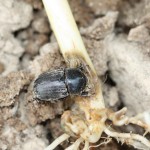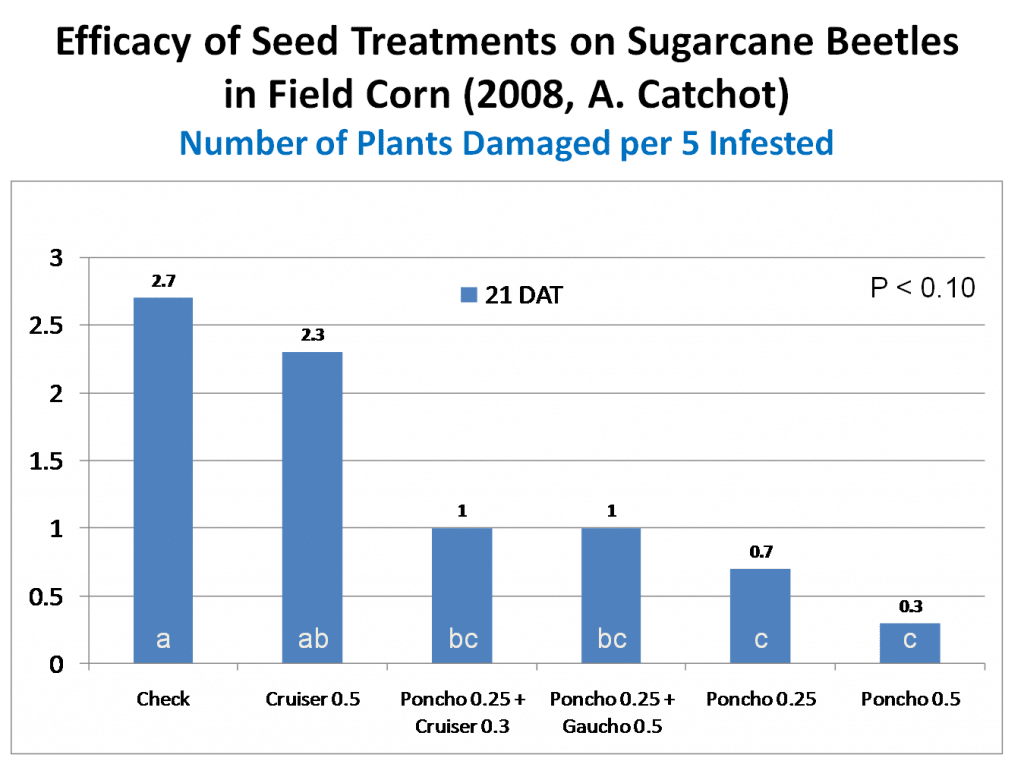Although a sporadic pest, sugarcane beetle caused significant losses in some corn fields last year. In the worst cases, fields had to be replanted. Thus, I’ve had a number of growers ask about how to prevent this problem again. One problem is that it is very difficult to predict when and where infestations will occur. Sugarcane beetles are in the same family as June beetles. However, they are fairly easy to identify by the jet black color and fossorial (digging-type) front legs. Overwintering beetles become active during the spring. The large numbers attracted to lights at night during 2010 was a tip off that populations were high. Although the grubs feed on grass roots, it is the adults responsible for damage to corn and some other crops. The beetles generally feed just below the soil on the roots and root crowns of corn. Damage can cause deadheart, effectively making the plant a weed. Less severe injury will cause stunting and symptoms similar to nutrient deficiency.
Beetles migrate into fields and may damage plants up to 24-inches tall, but smaller plants are especially susceptible. Because the beetles typically fly in after planting, and because they feed underground, foliar insecticide applications are only marginally effective. Also, few corn acres are regularly scouted, so applications are often poorly timed and made after serious injury has occurred. The best approach to managing this pest is through the use of at-planting treatments.
Some insecticide seed treatments provide partial protection. Poncho is clearly superior to Cruiser, especially against high infestations. Below is some data collected by Dr. Angus Catchot, Mississippi State University, showing the advantage of Poncho over Cruiser. However, Poncho 250 is sometimes not enough depending up the level of infestation and how long after planting the beetles moved into the field. Poncho 500 rate or higher is probably the rate needed for consistent control of sugarcane beetle.
Unless special ordered, your seed will likely come standard with either Poncho 250 or Cruiser 250. So what can you do to improve these treatments? One approach is to use in-furrow granular insecticides. Of course, few folks are interested or equipped to make these applications. Another and maybe more effective approach is to supplement your seed treatment with an at-planting, furrow spray of Bifenthrin (e.g., Brigade 2E, Discipline 2E or Fanfare 2E). A standard rate would be 0.3 oz/1000 row ft, which is equal to 5.1 oz/acre if on 30-inch rows. Honestly, I don’t have much data on how much this would improve control, but I suspect it would work pretty well. This treatment can also supplement the control of other pests such as cutworms.
Tip – You can apply this insecticide with starter fertilizer, but you will get better insect control if you band the application over the open furrow and get some insecticide on the “shoulders” of the seed trench. Be sure to read the label and follow instructions for tank-mixing with a starter fertilizer.





